Vehicle Inspections Software
Trusted across industries


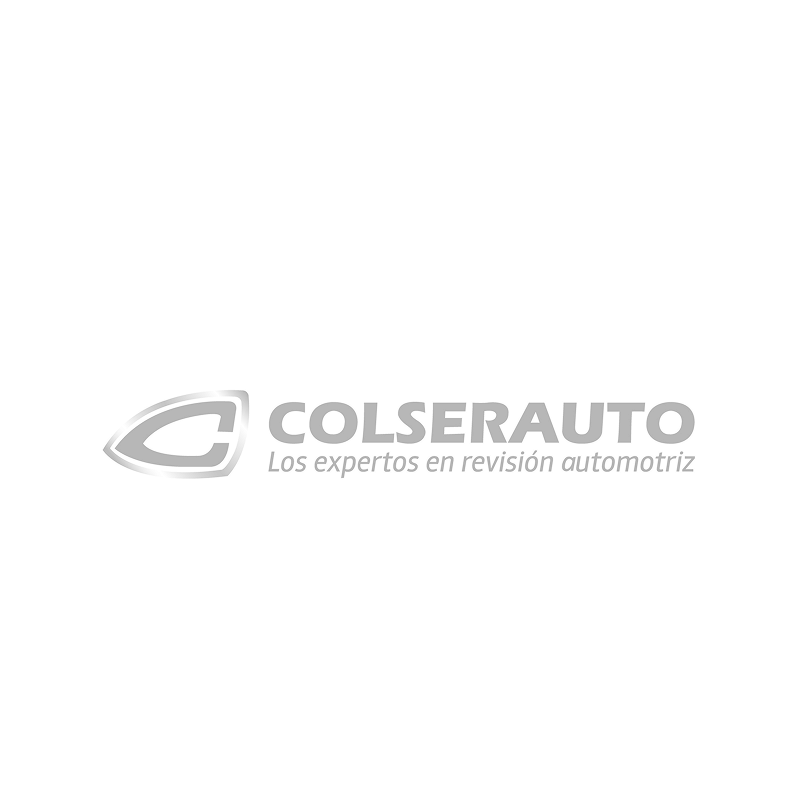










How it works
Scan any vehicle
Scan any vehicle effortlessly with our 360° guided system. Visual AI detects damages istantly-no expertise required.
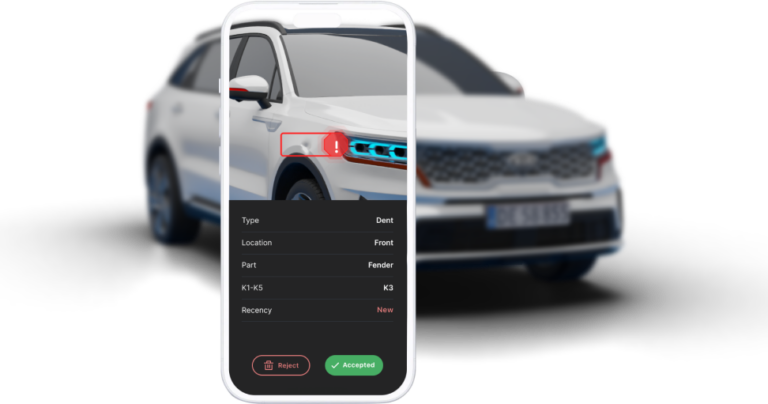
Actional reports
After the scan, a detailed vehicle condition report is generated, logged, and accesible in your system. Receive alerts on new damages and more.
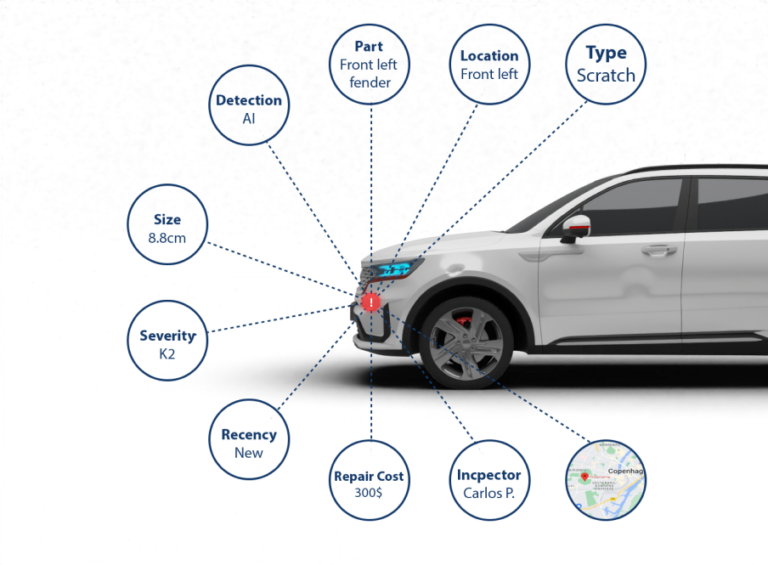
Track and monitor
Manage your damages and inspections from your dashboard. Customize functionality and acces for different user groups.

68%
Correct adjudication
Actual vs. planned inspections
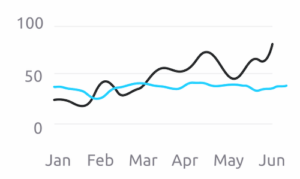
67k+
Damages detected

17,254
nspections completed
AI Use Cases for Vehicle Inspection Software
Vehicle Delivery Inspection
New cars are received at the location, inspected for damage, registered, and prepared for use.
Pre-Delivery Inspection
Ensures new vehicles are road-ready, checking mechanical, safety, and cosmetic aspects before delivery to the customer.
Check-In/Check-Out Inspection
Inspection and documentation of a vehicle's condition, mileage, and fuel level during customer pickup and return.
Used Car Sales Inspection
An evaluation of a used vehicle’s mechanical, safety, and cosmetic condition to ensure it meets quality standards before resale.
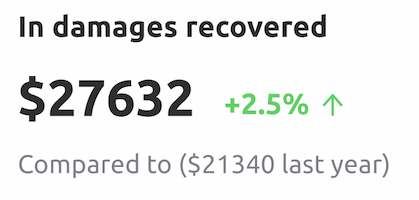
Integrate with any platform
Our solutions works across every platform and integration that your organization may need

Standalone systems
Standalone systems
A mobile app for iOS and Android, plus a web platform for managing inspections and customizing processes and user roles.

Integrated functionality
Integrated functionality
Easily add our features to your existing iOS, Android, or web apps with a quick SDK integration.

Plug & Play API
Plug & Play API
For customers with existing image capture systems, our API analyzes uploaded images for potential damage and returns results in real time.

Datapoint processed per inspection
To process an image
Total datapoints analyzed
Loved by industry leaders

"Focalx has improved our control over damage handling in our rental fleet. Its clear documentation provides transparency to customers, simplifying communication and strengthening trust."
Morten Lyng
CEO

"Since using Focalx, we've cut costs and improved efficiency—seeing clear financial benefits."

Christina Carpens
CCO

"Thanks to Focalx's AI, we saw ROI in the first month by catching damage we could've missed."
Steffen Ness
CEO

"With Focalx, I'm confident I can grow my business and capture more market share."

Martin Gerlach
Owner & CEO

"Focalx has streamlined our inspection process, saving time and increasing customer satisfaction. Remote inspections give customers flexibility and provide all the details needed at lease end."

Carly Taylor
Manager

“Since using Focalx, our inspections are faster, simpler, and much more straightforward.”

Mathias Schaadt-Hansen
Business developer
Frequently asked questions
We have put together some commonly asked questions
What’s the advantage of using AI for vehicle inspections?
AI enables faster, more accurate inspections, minimizes human error, and ensures standardized data collection.
My inspection process is already quick. How does this save time?
By automating damage detection and reducing manual effort, inspections become faster and free up your team for other tasks.
When do customers normally start to see ROI?
Most customers start to see ROI within the first 3-6 months, depending on their inspection volume and processes.
How can I be sure that the AI performs from day 1? Doesn’t it need training?
The system comes pre-trained with anonymized and synthetic data. Additionally, our validation team ensures AI performance during the onboarding phase.
Want to see how it works?
Join teams transforming vehicle inspections with seamless, AI-driven efficiency
Further reading

How Car Rental Damage Scams Work
In a typical car rental damage scam, renters return the vehicle in the same condition as when they picked it...

AI for Decision-Making: How AI Weighs Data and Makes Choices
Artificial Intelligence (AI) is revolutionizing how decisions are made by processing vast amounts of data with speed and precision. From...

AI with IoT: How AI Powers Connected Devices
Artificial Intelligence (AI) supercharges the Internet of Things (IoT) by turning connected devices into smart, autonomous systems. From optimizing smart...

AI for Fresh Data: Real-Time AI Training and Adaptation
AI for fresh data enables real-time training and adaptation, keeping models current with techniques like online learning and federated learning....

AI for Writing Code: How AI Assists in Software Development
AI is revolutionizing software development by writing code, suggesting fixes, and automating tasks with tools like GitHub Copilot and ChatGPT....

AI for Optimization: Enhancing Efficiency in AI Systems
AI for optimization uses techniques like genetic algorithms and gradient descent to boost efficiency in systems, from resource allocation to...

AI Without Bias: Can AI Be Truly Neutral?
AI often inherits bias from human data, making true neutrality a challenge, but techniques like bias auditing, diverse datasets, and...

AI with Human Oversight: Balancing Autonomy and Control
AI with human oversight combines machine autonomy with human judgment to ensure accuracy, safety, and ethics. Striking the right balance...

AI with Real-World Data: Challenges and Solutions
Using real-world data in AI is tricky due to issues like noise, bias, and missing values, but solutions like data...

AI Without Supervision: The Power of Unsupervised Learning
Unsupervised learning lets AI uncover hidden patterns in data without human oversight, powering breakthroughs in clustering, anomaly detection, and more....
Elevating Vehicle Inspections with Cutting-edge Software
Raising the bar of vehicle inspection routines with cutting-edge software is the next frontier for the automotive industry. This article uncovers the inner workings of AI-powered vehicle inspection software, scanning the main benefits for vehicle pick-up, onboarding, and documentation, as well as for fleet managers. We will then consider the primary applications of autoinspection, from remarketing to rental car agencies. Finally, this article will assess the way focalx’s innovative software tool is leading the way as the number one choice for AI-powered vehicle inspection software and vehicle lifespan optimisation.
Throughout the vehicle lifespan, vehicle inspections are essential for ensuring vehicle safety and compliance with legal regulations. From the moment vehicle manufacturers release a new vehicle for shipping and sale, to when customers further down the supply chain rent a vehicle or companies schedule a vehicle repair, the autoinspection process serves as a benchmark to check vehicle health at a given point in time. As a cornerstone of modern fleet management, fleet managers can scale and adapt vehicle inspection software to fleet management systems, as one of our other articles explores.
The Nuts and Bolts of AI-powered Vehicle Inspection Software
Focalx specialises in AI-powered vehicle inspection software which offers a 360-degrees guided capture of vehicle health for both vehicle interior and exterior. Our intuitive design empowers users and customers without requiring detailed onboarding or training. In this way, our technology is far reaching and scales to a variety of vehicle management systems and organisational structures. Moreover, the modular system enables the user to select which images are important on each interface. Companies can then customise and tailor the app and website interfaces to the needs of their vehicle systems.
Benefits of Vehicle Inspection Software
The prime benefits of vehicle inspection software are time and cost optimisation and improving overall reliability. With the vehicle inspection market for cars undergoing a transformation from 95% manual inspections to automated digital inspections, autoinspection now take less than three minutes with AI-powered software.
Focalx’s cutting-edge vehicle scanning software enables AI damage detection, including a functionality for entering additional damage into the app. The precision of focalx’s AI-powered scanning tool allows for accurate and reliable reporting on the status of tyre health, as well as any interior or exterior car damages.
Other examples of such software include Michelin’s QuickScan device which integrates with ProovStation’s interface to produce a detailed inspection report. Focalx’s technology enables multiple integration across interfaces so that companies can get the maximum value out of every damage.
Using a customised grading system, companies can categorise damage according to their business needs. This article will now take a deep dive into the four pillars of vehicle inspection software which bring maximum value to fleet managers and customers alike:
Picking Up and Dropping Off Vehicles
Picking up and dropping off vehicles is the first stage where customers and fleet managers interact and use focalx’s scanning tool to check for damages and quickly log overall vehicle health from a mobile app, eliminating the need for manual labour.
Our technology enables companies to add a layer of transparency to customer experience and business relationships in three main contexts. Firstly, focalx’s AI autoinspection software enables seamless documentation of vehicle condition for companies who are delivering a new car to customers and need to show them evidence of car health when they pick up and drop off the car.
Another incidence of pick-up and drop-off is receiving or delivering vehicles at the workshop, where handling customer vehicles requires mandatory inspection and documentation. Finally, in the context of transport management systems, focalx’s vehicle-scanning solution enhances transparency and contributes to company best practice by ensuring vehicle inspection can continue while transporting each vehicle. The net result of this AI-enhanced optimisation is that external partners will gain confidence in the provider and appreciate this high level of transparency.
Offboarding Vehicles
Offboarding vehicles is another area where enhanced autoinspection can contribute to greater transparency, time and cost optimisation, and a better customer experience. The more insights a vehicle management company can gain into vehicle safety and health at the offboarding stage, the better the overall customer experience will become. In the case of offleasing vehicles, companies can gain first-hand knowledge of vehicle condition, its residual value, and digital documentation of the vehicle’s roadworthy status for the relevant insurance company, leasing company, and internal team.
According to Eliron Ekstein, CEO and cofounder at Ravin AI, Original Equipment Manufacturers (OEMs) can use AI-powered inspection software to reinvent the digital customer journey at the stage of lease-end experience. In this way, the average customer who is a non-subject expert can assess their vehicle health and receive accurate, quality documentation about the status of their vehicle.
Filing and Processing Claims
Filing and processing claims is another benefit of implementing vehicle inspection software within fleets of cars. Using our AI-powered autoinspection app, fleet managers can automate claim handling for increased efficiency. Whether for personal, customer, or third-party claims, companies can benefit from optimisation in their claims processing. Digital personal claims reporting enables fleet managers to run a report every time they need to file a claim, organise all relevant data and documentation, and communicate with their insurance company to resolve all issues.
In the case of customer claims, fleet managers can ask their customers to run an inspection whenever they need to file a claim, improving the customer experience with additional transparency and simplicity at a moment of important safety checking.
For third-party claims, companies can take advantage of focalx’s app to ensure compliance with insurance regulations and run inspections whenever they need to file and log claims. This quick and easy process to check vehicle health and file insurance claims empowers third parties to communicate with the policy holder. In any instances of claim dispute, the user can access a vehicle inspection report to resolve the dispute with efficiency and transparency.
Fleet Management
Fleet management is a fourth application of vehicle inspection software, enabling fleet managers to make smart decisions for their fleet. The multiplatform systems available at focalx empower fleet managers to oversee vehicle inspection processes and keep tabs on documentation on the web platform from the comfort of their desks. Meanwhile, companies can customise access and functionality for different user groups. Our software allows fleet managers to inspect the vehicle each time they change drivers, allowing for a better overview of fleet driver allocation.
Vehicle branding control is another area where routine vehicle inspection ensures that the branding of a fleet is clearly visible and aligns with regulations for safety and optimisation. Synchronising with Periodical Technical Inspection (PTI) regulations supports fleet managers’ proactive monitoring of brand visibility and minimises the likelihood of miscommunication due to lacking documentation.
In terms of the product life cycle, vehicle branding control begins at the start of the vehicle’s lifespan, and OEMs can embrace customer demand for general-purpose remote assistants, as part of building a connection between the driver, car, and fleet management company, within an overall relationship with the brand.
By embracing a hybrid approach to vehicle inspection software, companies can integrate dashboard features and as well as others from the cloud. An embedded solution to vehicle branding control which anticipates in-vehicle driver needs and virtual assistant support, as well as vehicle inspection software on multiple platforms strengthens a positive and integrated experience of the brand for companies and customers alike.
Applications of Auto-Inspection
The big names in the global automotive industry, including Jaguar Land Rover and Toyota, are now transitioning to using auto inspection to replace manual labour associated with inspection across the vehicle supply chain. The key perks of using the combined power of automation and machine learning include cost and time optimisation, better safety outcomes, and increased driver efficiency. We will now examine four core applications of vehicle inspection technology:
Re-marketing
Re-marketing used cars in the automotive sale process requires vehicle inspection as a mandatory procedure to ensure compliance with safety regulations and verify a car’s roadworthy status. Automating vehicle inspection processes is beneficial for speeding up the sale of used vehicles at the right price, after assessing necessary repair costs. According to Michelin, vehicle inspections typically take half an hour per vehicle. Using AI-powered technology to support vehicle inspection processes cuts this time to 3 minutes.
As well as being time consuming, manual vehicle inspections are costly. Autoinspection technologies therefore cut administrative workload and unit cost. Furthermore, automated vehicle inspection ensures a standardised digital process where fleet managers can log customer feedback and additional costs appear in an app, receive detailed inspection reports, and provide documentation for insurance companies.
Car Dealers
Car dealers can also take advantage of automated vehicle inspection processes to support customers after they have purchased a car. In this regard, reliable tyre inspection enables AI-powered diagnostics to inform fleet managers of tyre health, optmising their maintenance operations across the fleet and potentially increasing the number of cars they sell.
Michelin’s QuickScan is a patented magnetic scanner which users can employ to assess tyre status and which is compatible with all kinds of tread design and tyre brand. Following a tyre check, the software provides a digital report which indicates any necessary maintenance operations for scheduling, including tyre replacement or switchover.
Fleet managers can incorporate Michelin’s QuickScan or Focalx’s software solution into their IT system with the help of Michelin’s Application Programming Interface (API). The net benefit of this software is the accuracy of the inspection report to build loyalty with customers, as a reliable, data-driven brand, as well as the ability of QuickScan to generate additional revenue from tyre-related services, from tyre replacement and switchover to tyre fitting, removal, or vehicle alignment.
Rental Car Agencies
Rental car agencies are a third application of AI-powered autoinspection technology. In a pilot with Ravin’s AI-enhanced scanning tool for rental vehicles at London Heathrow Airport, Avis reported that the vehicle inspection tool found 22% more minor damages, such as dents to the car exterior, than manual inspection procedures.
The multiple camera angles of this technology enable a 360-degree view of a car’s exterior. Moreover, the speed and reliability of this app-based mobile scanning software ensures that employees comply with regulations and do not rush through inspections, which could compromise vehicle safety for future customers.
Further pilot programmes involving other use cases in other locations would enable car rental companies to repeat and scale their initial successes with autoinspection software. In Avis’ case, pioneering AI-powered pilot programmes for rental fleets reflects a wider organisational paradigm shift, from operating as a conventional rental car company to becoming a mobility company.
Logistics
Logistics is an application of the automotive industry where large-scale damage to vehicle fleets can occur during transportation and needs investigation. In mid-October 2023, Amazon launched an Automated Vehicle Inspection (AVI) technology tool with the tech startup UVeye. Originally developed to detect bombs or unidentified dangerous material on the underbody of vehicles traversing access points such as border controls or airports, UVeye is a technology which utilises computer vision and deep learning algorithms to provide a complete vehicle inspection at drive-through inspection stations.
In the context of Amazon’s logistics supply chain, UVeye’s technology scans Amazon’s delivery vans for damage to the vehicle exterior and interior, including undercarriage wear, preventing escalation into full-blown problems. In this way, UVeye’s scanning tool ensures a van’s roadworthy status and stops safety issues from occurring during the transportation process.
The instantaneous report which this software generates enables fleet managers to check their vans’ status more reliably, leading to improved fleet safety standards and reliable delivery services for orders of goods. So far, nearly 300,000 van drivers have benefitted from from better on-road safety when they used UVeye’s technology in the delivery of Amazon packages to customers through Amazon’s Delivery Service Partners.
Conclusion
Taking vehicle inspection to the next level with automated app-based AI software is shaping company and consumer demand for better vehicle safety over the lifespan, as well as cost optimisation. Indeed, fleet managers can part ways with time consuming and less reliable manual vehicle inspection practices, in favour of a seamless software solution which derives from a smartphone app.
In the entry into this autoinspection paradigm, automated vehicle inspection technologies may integrate with systems of autonomous vehicles within corporate fleets used for delivery purposes or ridesharing. Moreover, connectivity within a wireless, fully digital system may enable communication between fleets within a larger automated infrastructure.
At the start of the process, OEMs may be able to incorporate a digital vehicle passport, where each user can log data about a vehicle’s status across the entire value chain. In this way, manufacturers, fleet managers, delivery drivers, and customers can all benefit from a reliable log of previous vehicle damage, ensuring optimisation of the process, minimal damage-related costs, and better compliance with safety regulations.